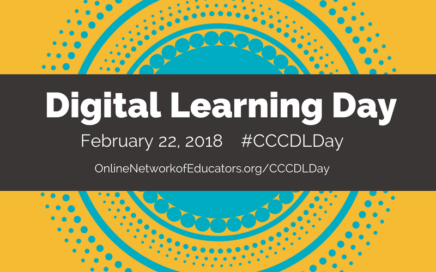
Pedagogy of Love: Teaching for Humanity
Pedagogy of Love: Teaching for Humanity Love is Essential Valentine’s Day celebrates love. Whether it’s romantic, fraternal, familial or personal, many recognize the power of love. No matter how you […]

Pedagogy of Love: Teaching for Humanity Love is Essential Valentine’s Day celebrates love. Whether it’s romantic, fraternal, familial or personal, many recognize the power of love. No matter how you […]

Get Ready for CCC Digital Learning Day Digital learning is anchored in connection and sharing. That’s why @ONE (Online Network of […]

Tweeting Your Way to Professional Growth This post is the third in a series about principles in teaching and learning with contributions by Jim Julius and Lene Whitley-Putz. Social media […]

Two Sides of the Same Coin: Online Teaching and Course Design This post is the second of a series about principles in teaching and learning with contributions by Jim Julius […]

Using Principles to Guide Professional Practice This post is the first of a series about principles in teaching and learning with contributions by Lené Whitley-Putz and Michelle Pacansky-Brock. In early December, […]

Using Video to Communicate Instructions Clearly Video is powerful communication tool for online teaching. Instructors often naturally gravitate towards using video to deliver presentations to their online students, but […]

I mentally stomped my feet when our counseling faculty recommended that, to better accommodate students, I offer my English 101 course, which is contextualized for first responders and administration of […]

How Snapchat, Zombies, and Twitter Can Humanize Learning Recently, I sat down with Mike Smedshammer from Modesto Junior College to discuss his thoughts about humanizing online learning. In our […]

Give ‘Em a Clear Learning Path Not all online courses look the same. That may seem a rather obvious point but it’s one that instructors may not realize regularly presents […]

I am sure some of us have a story (or 6 or 20) describing incidences in which a teacher or another student made us feel inferior, or out of place, […]

Hello! We are Liezl Madrona and Jayme Johnson, and we support faculty with accessibility in the Online Education Initiative. We are happy to bring you the first in an ongoing series […]

Captioning instructional videos can be a time-consuming process. But it doesn’t have to be! Here are a couple of “What if…” scenarios with some solutions to help you create an […]